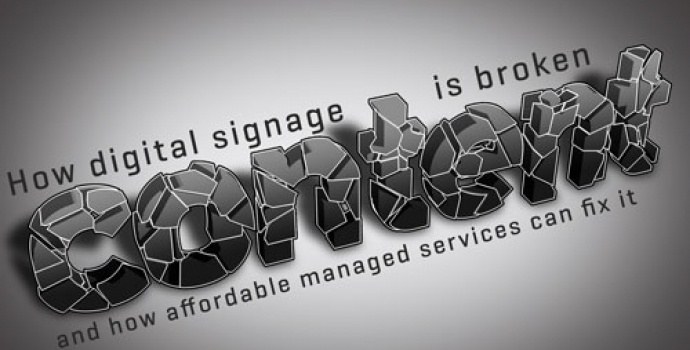How Digital Signage Content Is Broken – And How Affordable Managed Services Can Fix It
This article appears in the Sound and Video Contractor‘s July 2015 Issue
Digital signage, increasingly prevalent across industries, is now used in a variety of applications, among others, to communicate with employees, market wares to shoppers, track warehouse safety metrics, guide visitors through hotels and public places, and post-meeting room reservations. Digital signage is everywhere and growing.
But the common problem with Conference Room Signs and Meeting Room Digital Signage that spans industries and uses are, for the most part, that content is broken.
When called in to optimize existing digital signage networks, we have found that eight out of ten digital signage installations have fallen short of their original vision for development. That may not mean that 80% of digital signage customers are unhappy, because for some end users, if “the screens are working,” they feel their system is working. But that doesn’t mean their digital signage installation is operating as planned or offering a return on investment.
While working with a leading digital signage software firm, we observed that great attention was paid to ensure that the software, hardware, and installation were executed to perfection, but curiously, there was no discussion about how to ensure that the installation would be running effective content for their Conference Room Signs and Meeting Room Digital Signage.
“…BROKEN CONTENT IS THE EVENTUAL PRODUCT OF ONE-OFF GIMMICKY PROJECTS, OVERLY COMPLEX SOFTWARE TOOLS (OFTEN SOLD AS “EASY TO USE”), ADVERTISING AGENCIES UNFAMILIAR WITH THE MEDIUM, OR THE NEXT SHINY THING IN TECHNOLOGY DRAWING AWAY ATTENTION.”
Regardless of the reason, broken content is the eventual product of one-off gimmicky projects, overly complex software tools (often sold as “easy to use”), advertising agencies unfamiliar with the medium, or the next shiny thing in technology drawing away attention.
Gimmicky messages, images, or tech experiences are often “broken” after the first couple of uses. Take for example a software firm that has created a touch screen game where the user gets points for swiping at French Fries as they flowed across the 55-inch interactive screen. Most of us would try this game once- if it was free. But digital signage isn’t a free download from the Apple Store! Digital signage requires purchasing all the hardware, software, and funding content development. Because of its narrow scope, this particular fries game wasn’t a successful pilot, and there wasn’t much we could do for the developer.
Overly complex software products appear attractive until the realization that updates aren’t built-in and may not be possible if the in-house team lacks the necessary technical knowledge and creative ability to deliver regular content updates.
Digital and creative agencies may be a great resource for those who can afford them, but traditional ad agencies unfamiliar with producing content for digital signage tend to complicate the development process and can be costly, assuming they are not “learning” at your expense.
Unlike mobile app standards, the digital signage industry, in general, has not collected data to quantify the return on investment. In part, that is due to the fact that there are so many variables including venue, interior or exterior location, dwell time and audio applicability. That’s why the best practices for digital signage user interface (UI) design are often based on a composite of customer experiences.
And, designers who are new to the industry are at best-making assumptions about what looks good or functions well on a screen that is many times the size of a smartphone or tablet. All of which suggests the need for an affordable managed service that takes the burden of updating digital signage of the customer’s shoulders. End users who engage a Managed Services Provider (MSP) monthly instead of hiring an untrained full-time employee, have a flexible resource who is:
- Expert in the software of choice,
- Familiar with what works for digital signage in a particular setting, and
- Able to apply lessons from other customers in real-time.
With an MSP, customers – from Mom & Pop shops to the major technology group downtown – can afford effective digital signage, which makes budget less of a barrier to entry. Important because digital signage can be a very valuable tool for businesses and an important part of an A/V integrator’s offering.
Creating Margin is a member of the Digital Signage Federation, the only independent, not-for-profit trade organization serving the digital signage industry. The DSF supports and promotes the common business interests of worldwide digital signage, interactive technologies, and digital out-of-home network industries.


